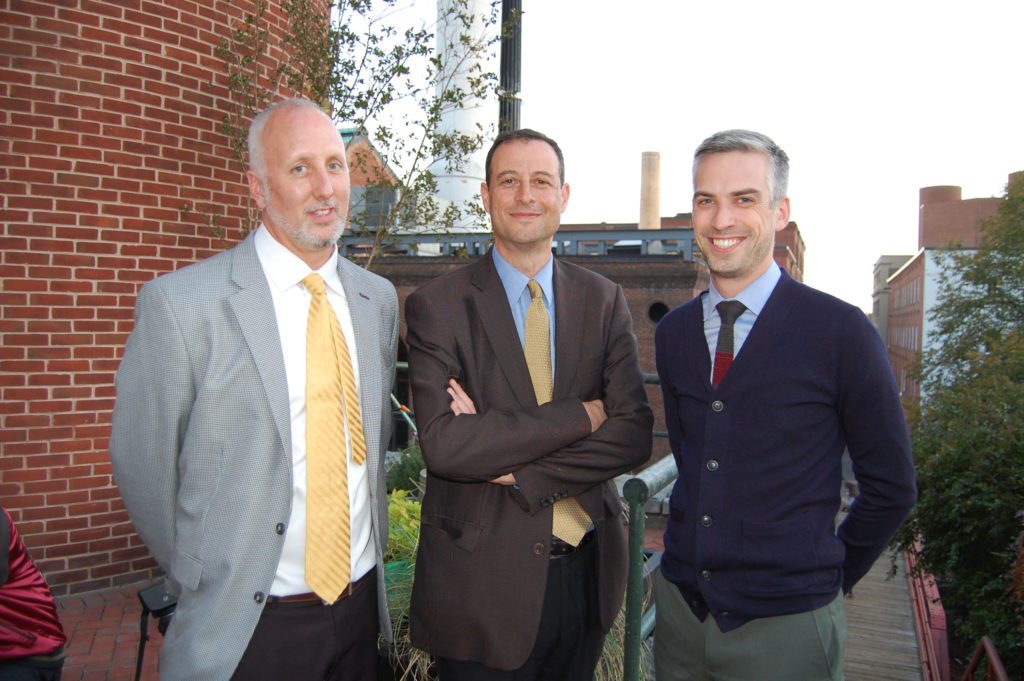BID’s Goal: A Safer, Cleaner, Friendlier Georgetown
By • November 8, 2017 0 637

Flower baskets hanging from streetlights … well-maintained benches, tables and blue chairs in and bordering neighborhood parks … clean curbs and sidewalks with little or no graffiti … expanded sidewalks along busy M Street on weekends … special shopping and entertainment events like the French Market and Sunset Cinema … holiday decorations and façade lighting, plus a monthlong festival of light art called “Georgetown Glow.”
These are some of the visible results of the Georgetown Business Improvement District’s initiatives over the past two decades, making the commercial areas of Washington’s oldest historic community safer, cleaner and friendlier.
Safe, clean and friendly was not the way many people would have described either Washington, D.C., or Georgetown as recently as the 1990s. Like many Georgetowners, Joe Sternlieb, the Georgetown BID’s CEO and president, can remember growing up in the District during the 1970s and ’80s, when it was losing population.
D.C. was rife with crime, dirty and (especially at night) dangerous public areas, failing public services and empty storefronts — and Georgetown was not immune. There were few appealing restaurants and even fewer places for residents and visitors to sit outside and enjoy the city’s historic sites and museums.
In 1996, the District Council decided to tackle the problem, passing enabling legislation to develop business improvement districts throughout the city. With the agreement of the majority of commercial property and business owners in defined business areas, special tax districts would be created. The additional funds would go to nonprofit organizations (“BIDs”) to plan and implement projects intended to make these areas safer, cleaner and friendlier for residents and visitors.
Since then, 10 BIDs have been created in D.C. (there are currently 74 in New York City). The Downtown DC BID was the first in the District; Georgetown’s, launched in 1999, was the third. BIDs generally have governing boards that are a cross-section of their commercial districts — the board of the Georgetown BID has 27 voting and seven non-voting members — and paid professional staff.
The Georgetown BID has a budget of about $3.8 million and 26 staff members. By way of comparison, the Downtown DC BID has an $11-million budget and 130 staff members, including 83 safety, hospitality and maintenance workers. The Golden Triangle BID (roughly defined by Lafayette Square, Washington Circle and Dupont Circle) has a budget of about $6.2 million.
Twelve BID staffers make up the full time “Clean Team.” With bright blue shirts, they can often be seen early mornings and late afternoons cleaning the sidewalks, curbs and street furniture throughout the BID’s arrow-shaped area (the wide shaft of the arrow is Wisconsin Avenue and the commercial side streets up to Book Hill and R Street).
The BID’s professional staff includes directors of transportation and economic development and various projects. Some have been with the BID for over a decade. In addition to Sternlieb — who, having hit the five-year mark, is the Georgetown BID’s longest serving chief — the top administrators are VP and Marketing Director Nancy Miyahira, CFO Michael Summey and Operations Director John Wiebenson.
“Since it is a special taxing district, every business in the BID area is automatically a member,” explains Sternlieb. “They can participate as little or as much as they want to, but all are contributors and beneficiaries of BID projects.”
There still is much to do. In 2013, the BID established a Georgetown 2028 Task Force to develop a comprehensive 15-year action plan. The “Georgetown 2028” plan — which the BID calls “a living agenda” — details 75 projects and dates of coordinated actions starting with “Restoring Georgetown’s Crown Jewel, the C&O Canal.” Other projects include public space improvements and economic development projects focusing on Wisconsin Avenue, the waterfront and the office market.
Among the proposed transportation projects, with the goal of “a better connected Georgetown,” are “developing a gondola over the Potomac,” “transforming K Street to a successful gateway,” “establishing Georgetown as a bicycle-friendly destination,” “better roadway and parking management” and “increasing the efficiency and usage of bus services.”
Going into 2018, the District of Columbia can be said to be a booming modern metropolis. The Georgetown BID’s brochure describes Georgetown today as “a neighborhood with a vibrant business district, active residential community, and popular recreational waterfront with 450+ shopping, dining and entertainment options in a beautiful, historic setting.” For that, says Sternlieb, “BID should get a little bit of credit.”
Georgetown 2028
Of the 76 action items (one was added), those currently in progress (46) are shaded in gray and those completed (11) are stamped COMPLETE.
The 11 completed items are:
3. Demonstrate new [C&O Canal] programs, activities and designs for public feedback
7. Install previously approved wayfinding system from DDOT
8. Explore physical and mobile expansions for wayfinding in commercial areas
11. Pilot temporary sidewalk widening programs
17. Create a forum for property owners on the 1300 and 1400 blocks to plan for the future 20. Explore policies to limit the holding of liquor licenses in safekeeping
44. Install in-street bicycle parking corrals throughout commercial areas
49. Improve the performance of intersections at the ends of the Whitehurst Freeway
51. Improve Wisconsin Ave. road allocation in Glover Park to reduce congestion & improve safety
67. Study a free hop-on/hop-off shuttle option within Georgetown and to Metro
76. Contract with DDOT to repair broken or missing bricks within 48 hours of being reported

